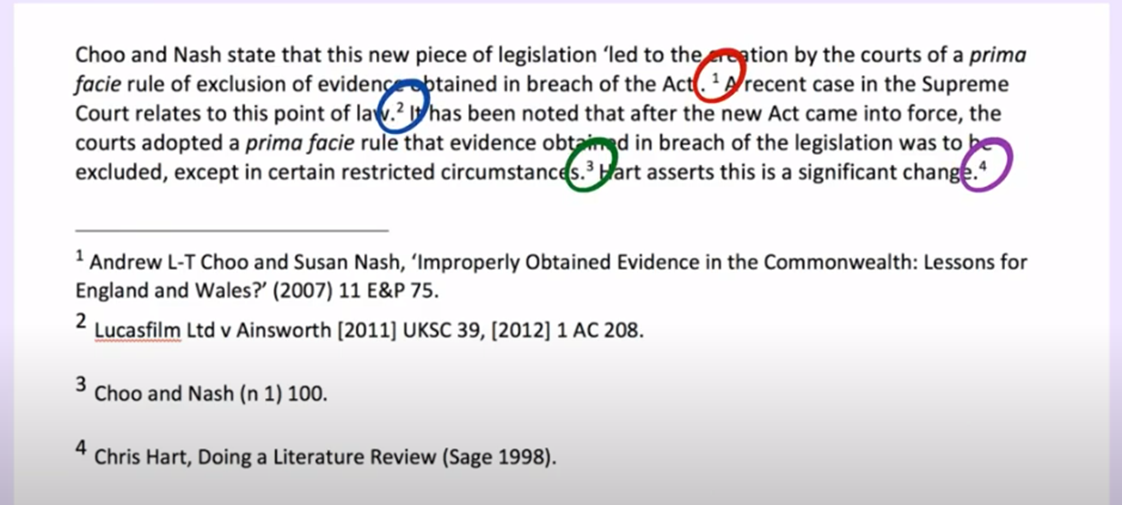Footnote
When referring to a publication for the first time, provide a full reference to the source at the foot of the page. Subsequent references to the same source can then be provided in abbreviated form.
Footnote Sample
 |
Insert a footnote marker after the full stop at the end of the sentence or after the word or phrase to which it relates.
At the bottom of the page, note the footnote number and give the full citation.
End the footnote with a full stop.
Number your footnotes continuously through your document, starting at 1
| When citing legislation, a footnote is not required if you have provided sufficient information about the source within the text |
Example 
Footnote Citations
-
All citations listed in the Reference list appear in footnotes.
-
Indicate footnotes with a superscript number.
-
Put the footnote marker at the end of a sentence unless it is necessary to put it directly after the word or phrase.
-
If there is a bracket, put the footnote marker before the closing bracket.
-
Close footnotes with a full stop (or question or exclamation mark).
-
Where more than 1 citations are given in a single footnote, separate them with semi-colons.
Examples
|
If the name of the case is given in the text, it is not necessary to repeat it in the footnote. It is well represented in the case law, perhaps most notably in the expression of the no-conflict rule advocated by Lord Upjohn in Phipps v Boardman, 31 and in the earlier Court of Appeal decision in Boulting v Association of Cinematograph, Television and Allied Technicians. 32
Footnote: 31 [1967] 2 AC 46 (HL). 32 [1963] 2 QB 606 (CA). |
|
Example of Law Reports: ….the case of Hong Kong & Shanghai Banking Cooperation v Syarikat United Leong Enterprise Sdn Bhd 2 . It can also be seen from the case of Ong ban Chai v Seah Siang Mong 3.
Footnote: 2 [1993] 2 MLJ 449 3 [1998] 3 MLJ 346 |
|
Give the name of the case in full when it is first mentioned in the text or footnotes; it may be shortened thereafter. Example: …Court of Appeal decision in Boulting v Association of Cinematograph, Television and Allied Technicians. 32 In Boulting [or ‘in the Boulting case], Upjohn said that the rule ‘must be applied realistically to a state of affairs which discloses a real conflict of duty and interest and not to some theoretical or rhetorical conflict’. 33
Footnote: 33Boulting (n32) 638. |
|
Examples: 12 Nuclear Installations Act 1965 (NIA 1965) s 7 (1) 15 NIA 1965, (n12) HOW TO ADD FOOTNOTES IN WORD |
Authors' Names
-
In footnotes, author's first name or initial(s) precede their surname.
Example: 12 Elizabeth Fisher OR 12 Elizabeth F
-
In bibliographies, the surname comes first, then the initial(s), followed by a comma.
An Author Examples
 |
 |
Three Authors Examples
 |
 |
IBID
- Means the same place.
- When 2 footnotes refer to the same source including the page.
- The 2 footnotes must be next to each other with no intervening footnotes.
Example:
3 Tan, Lee Meng, The Law in Singapore on Carriage of Goods by Sen, 2nd ed., (Singapore: Butterworths Asia, 1994), at 49.
4 Ibid.
Footnote 4 repeats footnote 3 exactly.
Example:
……..in the earlier Court of Appeal decision in Boulting v Association of Cinematograph, Television and Allied Technicians. 32 In Boulting [or ‘in the Boulting case], Upjohn said that the rule ‘must be applied realistically to a state of affairs which discloses a real conflict of duty and interest and not to some theoretical or rhetorical conflict’. 33
The relevant footnotes would appear as:
32 [1963] 2 QB 606 (CA).
33 ibid 638.
|
1 [2009] UKHL 5, [2009] AC 564 2 ibid [34] (Lord Hope), [39] (Lord Scott), [43]-[47] (Lord Walker), [58]-[60] (Lord Neuberger). ……. 7 Austin (n 1). |
- A citation for Austin v Commissioner of Police for the Metropolis is provided in footnote 1.
- As the name of the case is given in the text, it is not given in the footnote.
- The second citation at footnote 2 pinpoints several paragraphs in the case with an attribution to the relevant judge in brackets.
- The third citation at footnote 7 gives a short form of the case name and a cross-citation to the full citation.
|
1 Robert Stevens, Torts and Rights (OUP 2007). ……… 26 Stevens (n 1) 110. 27 ibid 271-78.. |
- Footnote number 1 shows a citation of a book which is first cited (in full).
- It is cited again in footnote number 26, with a cross-citation to footnote 1.
- It is cited again at footnote number 27.
|
27 Andrew Ashworth, ‘Testing Fidelity to Legal Values: Official Involvement and Criminal Justice’ (2000) 63 MLR 633. 28 Andrew Ashworth, Principles of Criminal Law (6th edn, OUP 2009) 68. ………. 35 Ashworth, “Testing Fidelity to Legal Values’ (n 27) 635-37. ……… 46 Ashworth, Principles of Criminal Law (n 28) 73. |
Format
Journal
Author, | ‘title of journal article’ | (year)| volume |journal name or abbreviation |first page of article
Book
Author (s), | title of book | (additional information, | edition, | publisher | year of publication)
|
32 Council Directive (EC) 93/104 concerning certain aspects of the organisation of working time [1993] OJ L307/18 (Working Time Directive) 40 Working Time Directive, art 2.
|
Document No.
Document No. WP/113
Issue 1
2 December 2022



